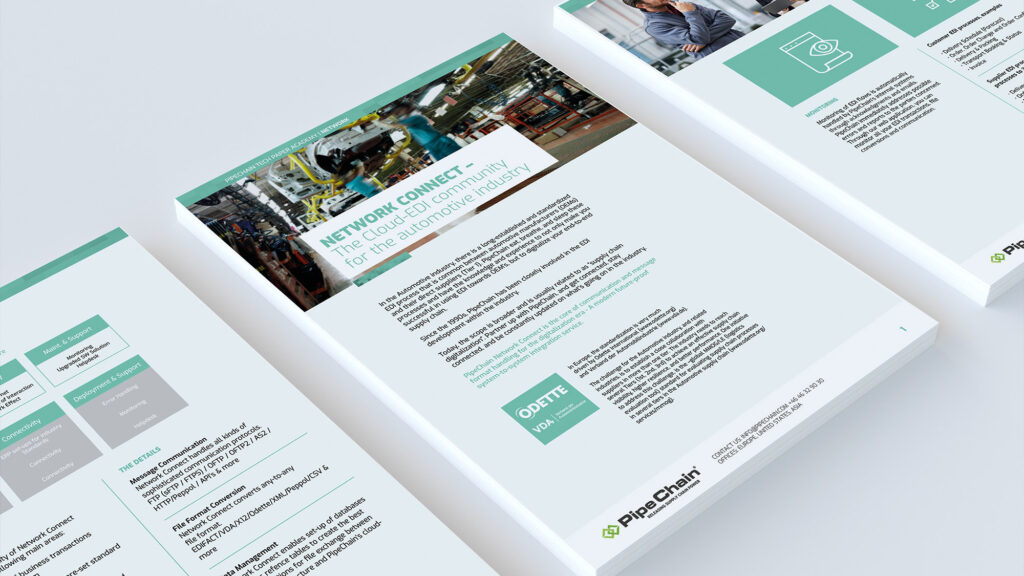
Start the AI and ML journey at the right level, and take it one step at a time
At PipeChain, we have a vision to deliver software solutions that support automated decision-making in supply chains. It is a vision that is based on two facts – firstly that the maturity of increased digital collaboration in the industry’s supply chains is gradually increasing, which it now does. Secondly, it is also a vision that can increasingly be realised thanks to the development of AI-supported software solutions.
When PipeChain was founded in 1999, our vision was based on much the same goal, but at the time we thought it was automatic stock replenishment based on information sharing of inventory balances, gross needs, actual deliveries and a number of critical parameters that would revolutionise the world’s supply chains. Instead, we now see an evolution ahead of us, driven by an increasing degree of digitalised flows within supply chains, increasing access to qualitative flow data and increasingly better conditions for building good decision-supporting cloud-based applications that, with the help of AI, can guide users to the right decisions. This will gradually drive the industry’s supply chains towards more efficient processes and smarter flows.
Identify your maturity
An important basis for successfully increasing the degree of cooperation in supply chains, with digitalised flows as the natural basis for this collaboration, is the understanding of where you as a company are in your degree of maturity. What I mean by this is that the managers in the company should understand where the company is, so the business can then develop further to an ever higher degree of maturity. Gartner has prepared an excellent description, using five degrees of maturity as a guide for this understanding.
Gartner’s maturity phases in AI development
Phase 1: React — Silo-based autonomous and reactive thinking
This phase is characterised by autonomous departments/units within the company – e.g. sales and manufacturing – that drive logistical priorities via manual processes and various non-integrated systems. There is a lack of holistic processes, standards and systems across functional boundaries and thus also coordination between them.
Phase 2: Anticipate — Functional thinking for scaling and efficiency
The logistics function is centralised in order to increase efficiency and productivity. Activities and performances are followed up from across the organisation and reported based on a holistic approach, which increases the ability to anticipate demand and thus improves the ability to plan operations. The focus is on creating standardised processes and methods in order to achieve economies of scale and increased efficiency for increased profitability.
Phase 3: Integrate — Integration of your business with your supply chain
At this point, the logistics function is integrated with the company’s entire supply chain. The focus is on understanding how logistics affects customer service, purchasing and manufacturing. Productivity increases and reduced costs are achieved through a higher degree of supply chain integration (customers, suppliers, third party logistics).
Phase 4: Collaborate — Collaboration with focus on your Value Chain Network
In this phase, logistics is an integral part of the company’s supply chain vision, where trade-offs between profitability and customer value can be made in a planned and conscious way. Customers and suppliers are integrated digitally and information sharing is significant, with a high degree of visibility on top of the pure transaction automation.
Phase 5: Orchestrate — Act as the conductor of your network to create customer value
The logistics and supply chain management solutions now support horizontal processes through the company’s ecosystem of business partners which, in addition to an efficient and profitable business, opens up new business opportunities. The business flow through the company’s supply chain is also real-time based, enabling further improved visibility, better informed decisions and also opportunities for increased market share and growth.
Part of the company’s digitalisation journey
Applying AI/ML to their supply chain flows requires this type of reasoning. In addition, most of the companies we come into contact with – before we start our digitalisation journey together with the customer – are in the equivalent of Gartner’s Phase 2 and entering Gartner’s Phase 3. This further means that AI/ML in Phase 3 should focus on the company’s own understanding of what is happening in the processes and the ability to use AI/ML to improve and refine decision-making. As supply chain work matures and evolves towards Phase 4, AI/ML support can increasingly aim at collaborative processes and improvements in joint decision-making for ever-increasing value creation.
IBMs maturity framework
In AI/ML there is a corresponding maturity reasoning, where, for example, in a report from 2021 (AI maturity framework for enterprise applications, March 2021), IBM highlights the following three levels:
Silver level: At this level, the company explores what AI is, how it can affect the business, what tools and technologies are required to start using AI, what data and what amount of data is required, etc. This is a level that does not affect the company’s business, but a level that aims to acquire experience and ideas for how AI can create value for the company.
Gold level: At this level, AI solutions create benefits for the business, without the staff involved having to be computer engineers to use the services. The data quality and the ability to create value through process automation are proven at this level.
Platinum level: Now the company has reached a level of AI usage where it is business critical for the business and organisation. The company now also relies on AI-based services and a crucial focus is on deviation management, where AI plays an important role. Ai capabilities are sophisticated at this level, which means that it is also in a phase where the company’s AI services are learning more and more gradually based on data from the reality the company encounters and the feedback the organisation provides to AI services.

Starting your AI journey
At PipeChain, we have a vision to deliver software solutions that support automated decision-making in supply chain flows, that both streamline flows with immediate value creation as a result, but also create greater flexibility and smarter flows that provide great added value in the long run. However, we have realised that both Gartner’s maturation phases for efficient and lean-based supply chains and IBM’s corresponding maturity rationale for the introduction of AI support into the business, mean that the AI journey we are now embarking on must start at the right level in order to succeed. We have therefore chosen to choose an industry segment that is in as mature a ‘Gartner phase’ as possible, i.e. Automotive, and customers of ours in this segment who have also come a long way in their digitalisation. Furthermore, based on IBM’s reasoning, we have chosen ‘Phase 2 Gold’, where our first AI/ML-supported application has access to enough qualitative data, is based on a process that can be highly automated and addresses an area with sufficient potential for improvement potential for users of our customers to get enough value out of the service.
A big first step for us…
Together with our customers, we therefore look forward with excitement to completing our software support for analysis of delivery plans within Automotive. The launch will take place in spring 2022. The software is of course cloud-based and contains as a basis a visual part, visibility of historical plans and their change over time, supplemented by traditional KPIs for forecast quality, over-forecasting and under-forecasting, and delivery precision. In addition to this functionality, we are introducing an AI service based on ML (machine learning). The purpose of the AI service is for it to be used as decision support regarding deviations that are ‘worth’ focusing and taking action on, or cancelled deviations where the AI service is trained so that it flags for call to action because it is not true that the deviation has failed. The starting point for our AI project has been to create an MVP (Minimum Viable Product), where the first step is for us to develop as limited a product as possible that at the same time creates enough value to be relevant to the market.
…but not for mankind (yet!)
Our AI journey together with our customers has only just begun, but it will still be a big step for us even if at this stage it is not a particularly great step for mankind. However, our vision is absolutely to help make the supply chain world better with the help of automated decision-making.
Insights

If you are interested in learning more about how to create a powerful connected supply chain, here are our latest insights.
Tech papers

To help you get a deeper and better understanding of our solutions and your supply chain, we have developed a number of detailed tech papers on different subjects.
-
Necessary
These cookies are not optional. They are needed for the website to function. -
Statistics
In order for us to improve the website's functionality and structure, based on how the website is used. -
Experience
In order for our website to perform as well as possible during your visit. If you refuse these cookies, some functionality will disappear from the website. -
Marketing
By sharing your interests and behavior as you visit our site, you increase the chance of seeing personalized content and offers.


